Few things are as distressing as the death of someone you’ve long admired, especially when they seem to have kept away from the spotlight for a while and you’ve just started to wonder what has happened to them. Death being a jolly final sort of thing left me a bit crushed as now it was certain that I would never meet Jocasta Innes. Well, it was never anything but a remote possibility, but on the principle that where there’s life, there’s hope….
Jocasta Innes died on the 20th April 2013, aged an astounding 78. I say astounding for in my mind she remains a vibrant, soignée 40 something, eternally chic, enigmatic, bohemian and ever-so-slightly wicked. Two of my daughters lived for some time in wonderful Spitalfield Houses. One backed on to Jenette Winterson’s house and the other on to Tracey Emin’s. ( At the top of the girls’ house a door opened on to a flat grassed area of roof and during one of the parties they had there Tracey, bad girl of British art, popped her head out of her attic window and expressed the hope that they wouldn’t be making a terrible noise all night long!) Anyway, I digress, my point is that I felt one day I was bound to bump into Jocasta Innes, another famous Spitalfields resident. But I never did and now I never will.
For many people, Jocasta found a way into their hearts with ‘The Pauper’s Cookbook” but for me it was “Paint Magic”. I longed to emulate her paint finishes and reproduce those wonderful rooms with stencilled cornices and marbled dados, although I did baulk somewhat a the paint recipes which seemed to involve dangerous cauldrons of boiling linseed oil. I was so relieved when she brought out her own range of stencil paints and scumble glazes which almost certainly saved me setting the kitchen on fire.
A family of 6 produces a great deal of paperwork and I had managed to track down an old filing cabinet with brass handles and label holders. Even if it proved too big for birth certificates and passports, school reports and public examination certificates, recipes to be looked at later and bank statements, I thought it would be a good place to stuff a jumper or two.
Tucked away in a dark corner behind a door, I fancied the filing cabinet painted black with gold foliage and flowers catching what little light came its way. Inspired by an indigo print of 1935 by a Danish textile printer, Marie Gudme Leth, I scaled up the flowers and cut them out of stencil card. First I painted the whole thing with a dusky red undercoat, then I sprayed gold all over that (but not worrying about perfect coverage as I liked the idea of the pinky-red undercoat showing through). When that was completely dry, I arranged the cut out stencils, used spray mount to hold them in place and then sprayed the whole black, peeling off the stencil cards very quickly afterwards in case they stuck too well. Doing one side at a time (top, front, left side, right side) I was able to let the stencils dry out and use them several times. Some gaps I filled in with sprigs of leaves I had pressed previously and these helped link the design over the front panels where the drawers open.
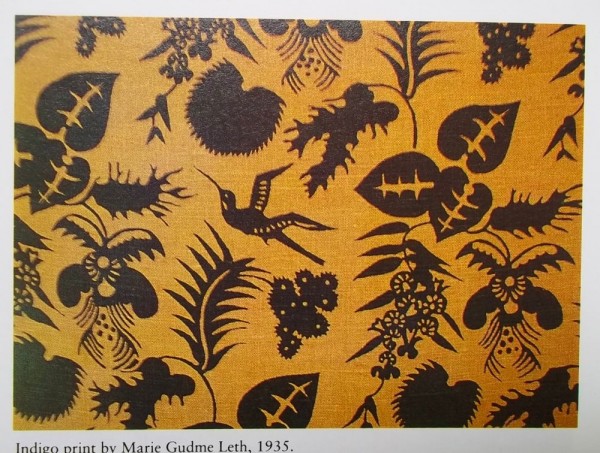
Indigo print: Marie Gudme Leth, 1935 (from ‘Modern Block Printed Textiles’ by Alan Powers, Walker books, 1992)
During the C19th English and German imported printed fabrics had had a disastrous effect on the local textile trade in Denmark. Marie Gudme Leth is credited almost single-handedly with reviving it, inspired by javanese batik whose production she had studied when she was out in the Far East.Like Josef Frank she liked to design generous floral patterns in which an Indian influence is visible, although in later years she preferred simpler shapes.
It is impossible to photograph the cabinet in its entirety as a bed and other pieces of furniture get in the way. This isn’t the ideal situation. I liked it best in a space behind a door where it had a mirror, a light and a tray of bits and bobs of jewellery. It did mean that you had to sing if you had the door closed and were peering into the mirror putting earrings on or something similar, otherwise you risked an exuberant child rushing in and flinging the door handle into the middle of your back. But it was rather nice when the door was closed and the light from the lamp cast its glow over the glinting gold leaves. I think it is down to Jocasta’s influence that many of us felt brave enough to do something so extravagantly decorative to something as down to earth as a filing cabinet and blow to what anyone else might think. I am surprisingly sad that she is no longer around.

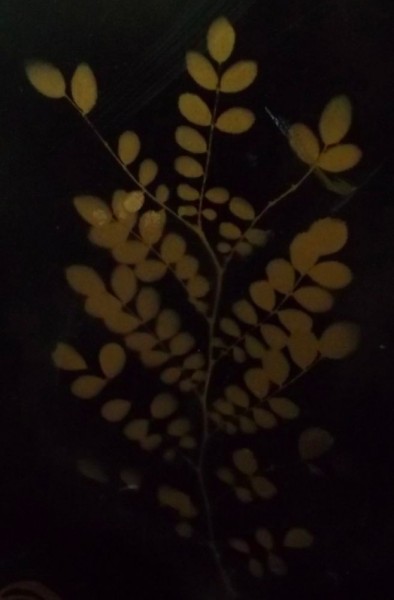
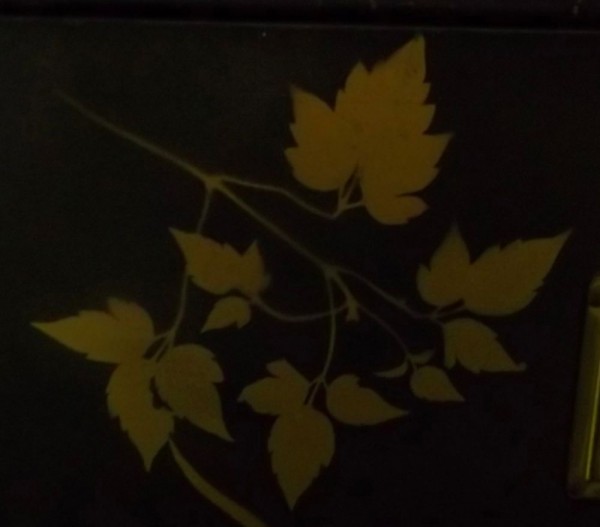
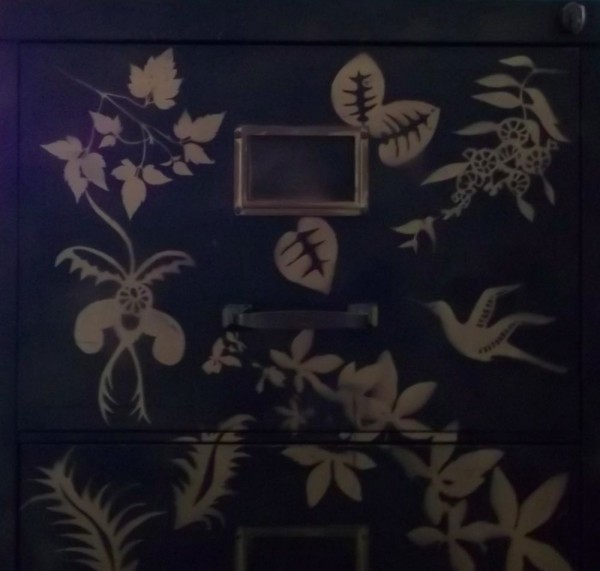
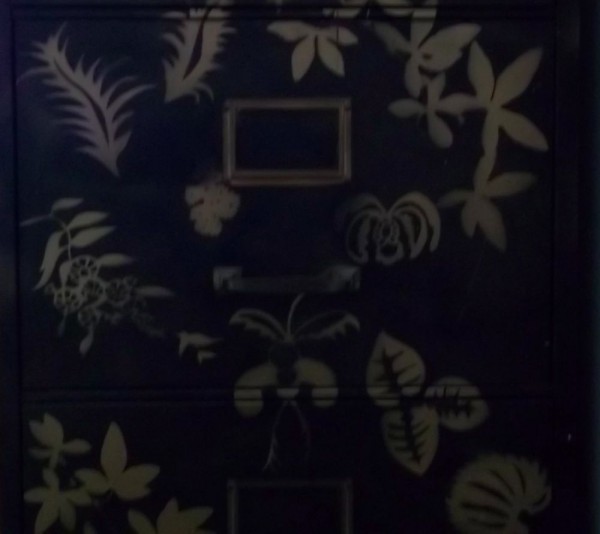
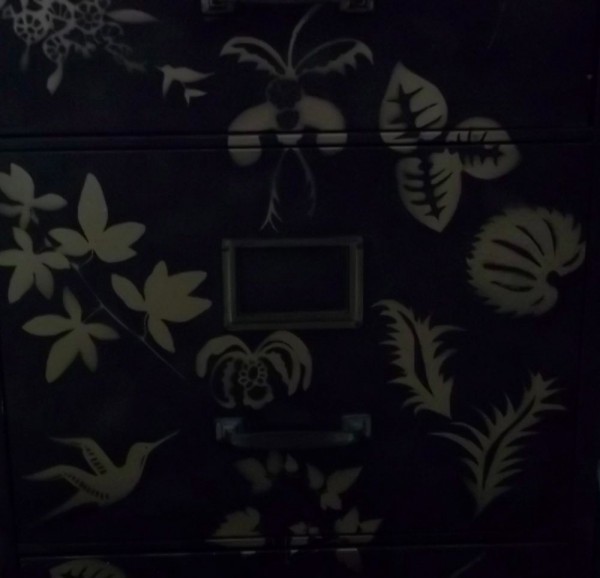
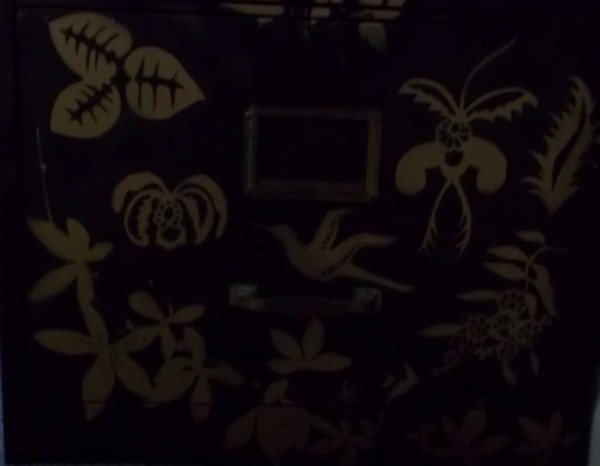
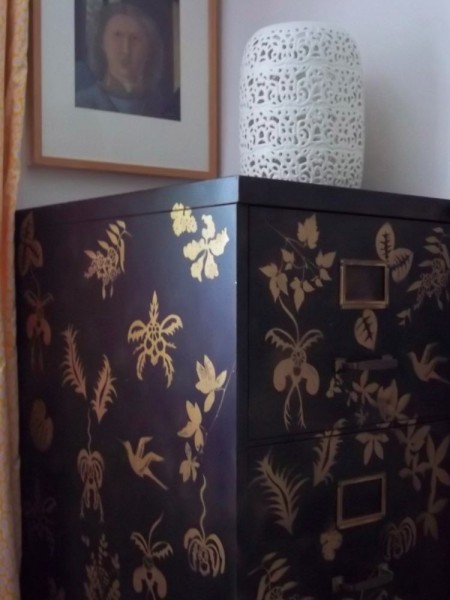
One Comment
I must have missed the notice that she had died and I ,too, am sorry to hear it.
I shall always remember your filing cabinet …it is a work of art in itself. It inspired me to also buy a filing cabinet but mine is sadly negelected with its original paint-finish in my cellar!